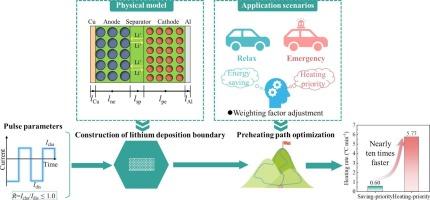Scenario-adaptive preheating path optimization for bidirectional pulses and lithium deposition prevention in high-SOC lithium-ion batteries
IF 6.4
2区 工程技术
Q1 MECHANICS
International Communications in Heat and Mass Transfer
Pub Date : 2025-09-30
DOI:10.1016/j.icheatmasstransfer.2025.109755
引用次数: 0
Abstract
Fast preheating of lithium-ion batteries at low temperatures while minimizing degradation remains a critical challenge in battery management. Bidirectional pulse heating has garnered interest among electric vehicle manufacturers due to its advantages in temperature uniformity, system simplicity, and compatibility with various battery shapes. However, its heating rate faces a sharp decline when heating high-SOC batteries due to the increased risk of lithium plating, rendering it unsuitable for emergency scenarios. This numerical study addresses this challenge by proposing a scenario-adaptive pulse preheating strategy, which removes the stringent requirement for equal charge throughput between charge and discharge pulses. This approach enables high heating rates while effectively mitigating lithium plating risks. An objective function is developed to identify the optimal heating pathway under various scenarios by balancing heating rate and SOC loss. Users can tailor the weighting factor to choose among heating-priority, energy saving-priority, or balanced modes. The simulation results reveal that the heating-priority mode achieves a remarkable heating rate of 5.77 °C/min even at 80 % SOC across a wide temperature range from −10 °C to 15 °C, nearly ten times faster than the energy saving-priority mode. This innovative strategy enhances the heating performance of bidirectional pulse and facilitates the promotion of electric vehicles in cold climates.

高荷电状态锂离子电池双向脉冲场景自适应预热路径优化及防锂沉积
在低温下快速预热锂离子电池,同时最大限度地减少电池退化,仍然是电池管理的关键挑战。双向脉冲加热因其温度均匀、系统简单、与各种电池形状兼容等优点,引起了电动汽车制造商的兴趣。然而,由于镀锂的风险增加,在加热高荷电状态电池时,其加热速度会急剧下降,不适合应急场景。该数值研究通过提出一种场景自适应脉冲预热策略来解决这一挑战,该策略消除了对充放电脉冲之间相等电荷吞吐量的严格要求。这种方法可以实现高加热速率,同时有效地降低锂电镀风险。建立了一个目标函数,通过平衡加热速率和有机碳损失来确定各种情况下的最佳加热路径。用户可以定制权重因子,以选择加热优先,节能优先,或平衡模式。仿真结果表明,在−10°C至15°C的宽温度范围内,加热优先模式即使在80% SOC下也能实现5.77°C/min的显着加热速率,比节能优先模式快近10倍。这一创新策略增强了双向脉冲的加热性能,有利于电动汽车在寒冷气候下的推广。
本文章由计算机程序翻译,如有差异,请以英文原文为准。
求助全文
约1分钟内获得全文
求助全文
来源期刊
CiteScore
11.00
自引率
10.00%
发文量
648
审稿时长
32 days
期刊介绍:
International Communications in Heat and Mass Transfer serves as a world forum for the rapid dissemination of new ideas, new measurement techniques, preliminary findings of ongoing investigations, discussions, and criticisms in the field of heat and mass transfer. Two types of manuscript will be considered for publication: communications (short reports of new work or discussions of work which has already been published) and summaries (abstracts of reports, theses or manuscripts which are too long for publication in full). Together with its companion publication, International Journal of Heat and Mass Transfer, with which it shares the same Board of Editors, this journal is read by research workers and engineers throughout the world.

 求助内容:
求助内容: 应助结果提醒方式:
应助结果提醒方式:


